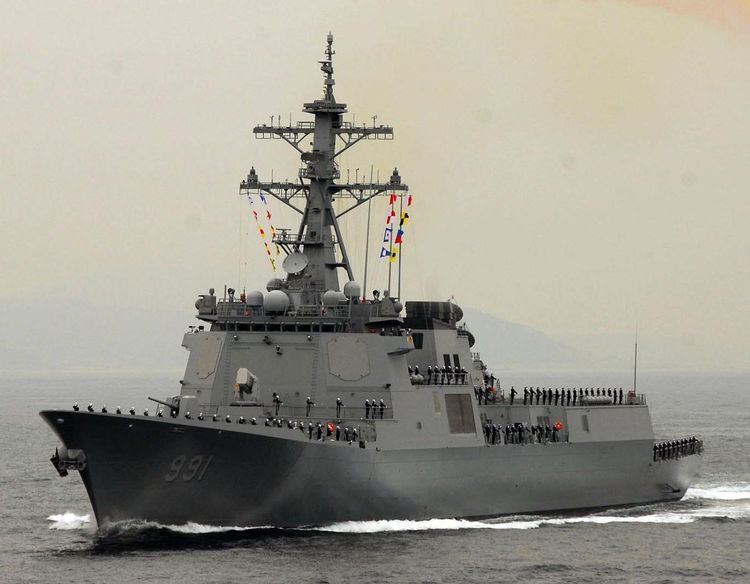Planned 6 | Building 3 | |
 | ||
Builders Hyundai Heavy IndustriesDaewoo Shipbuilding & Marine Engineering Preceded by Chungmugong Yi Sun-sin class Cost $923 million (per ship) | ||
The Sejong the Great-class destroyers (Sejongdaewang-Ham or Hangul: 세종대왕급 구축함, Hanja: 世宗大王級驅逐艦), also known as KD-III, are three guided missile destroyers of the Republic of Korea Navy (ROKN). The second ship was commissioned in August 2010 and the third in August 2012. As at 2013, the ROKN has deployed three ships with an option for three more; in December 2013 the option to acquire the second three was taken up.
Contents
Background
The ship features the Aegis Combat System (Baseline 7 Phase 1) combined with AN/SPY-1D multi-function radar antennae.
The Sejong the Great class is the third phase of the South Korean Navy's Korean Destroyer eXperimental (KDX) program, a substantial shipbuilding program, which is geared toward enhancing ROKN's ability to successfully defend the maritime areas around South Korea from various modes of threats as well as becoming a blue-water navy.
At 8,500 tons standard displacement and 11,000 tons full load, the KDX-III Sejong the Great destroyers are by far the largest destroyers in the South Korean Navy, and built slightly bulkier and heavier than Arleigh Burke-class destroyers or Atago-class destroyers to accommodate 32 more missiles. KDX-III are currently the largest ships to carry the Aegis combat system.
Armaments
Sejong the Great-class destroyers' main gun is the 127 mm/L62 Mk. 45 Mod 4 naval gun, an improved version of the same gun used on other warships from several foreign nations. Point-defense armaments include one 30 mm Goalkeeper CIWS and a RIM-116 Rolling Airframe Missile Block 1 21-round launcher, the first Aegis platform to carry RAM. Anti-aircraft armament consists of SM-2 Block IIIA and IIIB in 80-cell VLS. Anti-submarine warfare armaments consists of both K-ASROC Hong Sahng-uh (Red Shark) anti-submarine rockets and 32 K745 LW Cheong Sahng-uh (Blue Shark) torpedoes. Anti-ship capability is provided by 16 SSM-700K Hae Sung (Sea Star) long-range anti-ship missile, each with performance similar to the U.S. Harpoon. Land-attack capability is provided by the recently developed Hyunmoo-3C (Guardian of the Northern Sky) cruise missile, which is similar to the U.S. Tomahawk.
Missile batteries
Capabilities
The Sejong the Great-class destroyers' are often compared to the Arleigh Burke and Atago classes because they utilize the AN/SPY-1 multi-function radar, have similar propulsion and capabilities. One notable difference between the Sejong the Great-class ships and Arleigh Burkes is the number of VLS cells. Destroyers of the Sejong the Great-class have a capacity of 128 missiles, as opposed to 96 on the Arleigh Burke class and the Japanese Atago-class destroyers. The Sejong the Great class is thus one of the most heavily armed ships in the world, with even greater missile capacity than the U.S. Navy Ticonderoga-class guided missile cruiser that has 122 VLS cells and the same capacity as the Chinese People's Liberation Army Navy Type 055 destroyer, surpassed only by the Kirov-class battlecruiser with 352 missiles (entire missile load). Another similarity to Arleigh Burke Flight IIA and Atago-class destroyers is the presence of full facilities for two helicopters, a feature missing from earlier Arleigh Burke and Kongō-class destroyers.
These three destroyers have, according to South Korean newspaper Chosun Ilbo, the capability to "track and monitor any missile launched from anywhere from the North." This capability was demonstrated by the tracking of a North Korean missile in April 2009.
BMD
In August 2016, press reports revealed that South Korea was considering adding the SM-3 interceptor to its Sejong the Great-class ships to enable them to perform ballistic missile defense in response to North Korean efforts to bolster offensive missile capabilities. This comes just months after the U.S. decision to deploy the THAAD missile interceptor system on mainland South Korea. The addition of SM-3s to the ships may require software and computer hardware upgrades. The following month, Aegis manufacturer Lockheed Martin confirmed the next three Sejong the Great vessels will be capable of performing "integrated air and missile defense" (IAMD) to supplement U.S. Army ground-based missile interceptors on the peninsula, likely being outfitted with the SM-3. While the first three destroyers are fitted with Aegis Baseline 7 based on older proprietary computers that can't carry out IAMD operations, the following three will be fitted with the Baseline 9 version of the Aegis Combat System that combines modern computing architecture to allow the AN/SPY-1D(v) radar to perform air warfare and BMD missions at the same time.
Hull names
On April 20, 2007, Chief of Naval Operations of the Republic of Korea Navy announced that the lead ship of KDX-III class destroyers will be referred as Sejong the Great. Sejong the Great (Hangul: 세종대왕) is the fourth king of the Joseon Dynasty of Korea. He is credited with the creation of the Korean alphabet, Hangul.
Ships in the class
On 10 December 2013 the ROKN confirmed ordering three more vessels on the same class.
